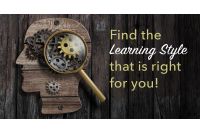Find the Learning Style that is Right for You
Find the Learning Style that is Right for You
Peter Fenger

Each person learns information differently. As you prepare for your exam, it is helpful to identify how you learn and retain information. There are three major learning styles which include auditory, visual, and tactile. This post will explore everything you need to know about the 3 learning styles.
What is an auditory learner?
An auditory learner finds the most benefit from listening to study material and questions. Also, they are better able to retain information if they read it out loud and then listen to the recording. For example, someone with this learning style will find it helpful to read the exam questions out loud and answer them. Speaking the information helps them remember it better.
Someone who is an auditory learner doesn’t mean that they don’t also learn information from visual and tactile styles. Auditory learners can absorb and recall information better when it is delivered through hearing. Knowing your learning style can cut down on test-taking anxiety and frustration.
You may be an auditory learner if
- You find it helpful to have someone ask the question, and you verbalize the answer to them
- You like someone to tell you directions versus reading directions
- You discuss answers versus write out answers
- You use rhymes to remember information
- You read questions out loud then you provide the answers
Tips to help auditory learners
- Listen to recordings of exam questions and study material
- Read each exam question out loud then verbalize the answer
- Record your reading of questions and answers in a voice memo app
- Describe information in detail including steps and processes
- Participate in group discussions of exam material
What is a visual learner?
A visual learner is someone who likes to see what they want to learn. The space that is created by visually seeing information aids in the learning process. The term for this is visual-spatial learning.
If you like to see concepts written out versus hear about them, you are a visual learner. Your ability to see how the information looks helps you absorb the material and memorize it. Just because you are a visual learner doesn’t mean that you don’t include other learning styles such as auditory or tactile. The goal is for you to identify the best way you learn the material then align your study plan to match it.
You may be a visual learner if you:
- Make lists to help you learn or stay organized.
- Find it useful to write out your thoughts and ideas.
- Prefer reading material and study guides versus listening to audio recordings of the same information.
- Find it helpful to highlight, underline, or make notes in your study guides.
- Re-write information you have learned. For example, you re-write lecture notes.
Tips to help visual learners
- Write things down. Whether it’s a term or process, be sure to write it out.
- Utilize flashcards to help memorize and understand the material.
- Watch videos that cover the concepts and theories you are learning.
- Visualize critical concepts as symbols, acronyms, or picture. For example, in learning systems, draw a diagram or image to represent it.
- Arrange your notes in an outline.
What is a tactile learner?
A tactile learner is someone who learns through movement. This learning style is often forgotten because it isn’t as traditional as auditory or visual. A tactile learner can better absorb and understand new material through movement of the body.
Pay attention to how your body moves and reacts during your next study session. Is your pencil moving or tapping as you read? Does it help to read the material out loud as you walk throughout your house? This learning style is a powerful one, and your study program can benefit from implementing more tactile learning.
You may be a tactile learner if
- You continuously move your leg or shake your leg while reading.
- You talk with your hands.
- You have good hand-eye coordination.
- You are good at sports.
- You like to use a pen or highlighter to make notes while reading.
Tips to help tactile learners
- Place toys or objects you can play with on your desk while studying.
- Listen to audio study guides while you are exercising.
- Stand up and walk around while you read new material.
- If you feel tired while studying, stop every 30 minutes and do a few jumping jacks.
- Keep a sketch pad handy during study session so you can draw diagrams or systems.
Combining your learning style and the right study aids is crucial to your exam preparation. Set up an appointment with one of our AATBS consultants for an overview on how each package can cater to your learning style.
Understand Your Study Options
This Sample Kit will give you an introduction to your licensing exam, available study options, as well as samples of our study volumes, practice questions and free flashcards.
Download Free


